General Costs:
The tabulated costs associated with green roof design and construction are driven by the type of green roof, the scope of each component, and the aspects of the roof. Macroeconomic factors will likewise affect the cost of green roof construction. Generally speaking, green roofs cost between $10.00 and $30.00 per square foot to install, with annual maintenance costs ranging from $0.75 to $1.50 per square foot (Baker, n.d.).
Intensive green roofs are limited in that they can only be installed on buildings with a flat roof. Traditional flat roofs typically cost anywhere between $7.00 to $12.00 per square foot to install (Learn How Much It Costs to Install a Flat Roof, 2018). There are three common types of flat roofing. All of which have slightly different perks but overall similar costs. One type is called a “built-up roof” which is composed mostly of tar and gravel. Another is modified bitumen, which is made of various compounds and can be rolled or “peeled and stuck” conveniently. Lastly, a flat roof can be made of a rubber membrane which is lightweight, durable, resists sun damage, and is easy to repair (Learn How Much It Costs to Install a Flat Roof, 2018). The biggest benefit of flat roofs is that, when treated properly, they are capable of being walking on safely. Furthermore, this allows them to hold entities such as intensive green roofs and gardens (Green Roofs for Healthy Cities, n.d.).
Green Roof Service Life:
An additional benefit of green roofs is that they extend the lifespan of the building’s roof by protecting against diurnal fluctuations, UV radiation, and thermal stress (Feng, 2018). Green roofs have a service life of 30 to 50 years, but must be maintained in order to remain safe and functional (Feng, 2018). When a green roof is created, its first years of existence are called the “establishment period” (General Service Administration, 2011). This period requires additional attention to the young plants as they acclimate, including additional watering and removing weeds to ensure the vegetation develops properly. Maintenance is critical to the long-term success of the roof; costs are highest for both for extensive and intensive roofs during the establishment period, however, intensive green roofs require more frequent and longer visits than extensive green roofs due to their components especially following this period (General Service Administration, 2011).
If an intensive green roof is installed with crops, they have to be tended to and the garden has to be maintained as well. This inherently creates a market for jobs in the green roof business. The process involves installation, gardeners, repairmen, and others, which in turn, creates jobs as well as a new domain in the construction and agricultural industry. Maintenance includes weeding, harvesting, and distributing grass to improve coverage as well as checking the growth medium and inspecting for other potential problems. Following the establishment period, maintenance requirements will decrease (General Service Administration, 2011).
Effects on Green Roof Costs:
Broadly speaking, green roof costs are determined based off of type (extensive and intensive). Because extensive green roofs work to abate environmental issues like stormwater runoff, air quality, and the urban heat island effect with minimal human interaction, they generally run a lower cost than intensive green roofs. Intensive green roofs work to do all of the above while providing a space for the community, which requires reinforcements for additional load bearing capacities. Extensive green roofs cost between $10.00 to $20.00 per square foot while intensive green roofs cost between $20.00 to $40.00 (Peck and Kuhn, 2016). Macroeconomic elements can greatly affect the cost of these green roofs. The people that dictate these costs are the green roofs companies that work in the business. Factors that could influence costs are listed below:
- Project location
- Size and slope of the roof
- Height of roof above grade
- Availability of labor
- Accessibility by crane
- The structural capacity of the roof deck
- Location and type of roof drainage and waterproofing
- Use and specific features desired (i.e. deck, pavers, trees, turf, other)
These factors affect specific costs associated with green roof installation and maintenance. In order to determine the costs associated with each of these aspects, green roof installation companies have created several planning guides. These either craft specific green roof systems for an individual roof’s specifications and owner’s wants and needs, or they determine which predesigned system they created best fits those wants and needs. However, for those determining if a green roof is the right option to be implemented at all, the following guides serve as a starting point for determining green roof costs. (See Appendix). Figure 22 and Figure 23 below show which components of green roof construction are more costly than others. As indicated, much of the costs stem from re-roofing the existing roof and initial construction of the green roof system. Both of these costs can be adjusted greatly in conjunction with scope to fix the project to better meet the needs of the green roof. The other costs are either relatively negligible, involved with the initial design or necessary construction phase of the project, or optional
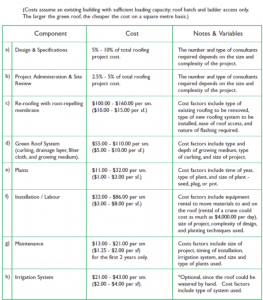
Figure 22. Cost ranges of the different components of extensive green roofs with the determining variables associated with each price range. Adapted from Design Guidelines for Green Roofs., S. Peck, S., & M. Kuhn, M., 2016.
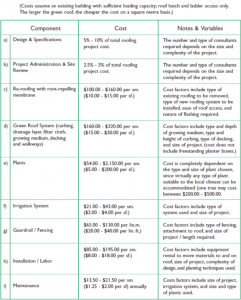
Figure 23. Cost ranges of the different components of intensive green roofs with the determining variables associated with each price range. Adapted from Design Guidelines for Green Roofs., S. Peck, S., & M. Kuhn, M., 2016.
Green Roof Scope:
As the scope of the green roof increases, the benefits granted to the community increase as well. Similarly, the larger a green roof is, the less costly the installation cost premium will be. Maintenance costs are high for a large green roof, however, the maintenance cost per square foot decreases the larger a green roof is. Therefore, the most effective green roof in terms of its cost to its benefit is one that is as large as feasibly possible. This effect is shown in Figure 24.
Green roofs have a large initial cost, as design, site assessment, and material costs must be paid before the green roof is even put in place. Therefore, green roofs are a large investment where most of the benefits will come at a later point in time (General Service Administration, 2011). Following construction and installation costs, the long term costs of the roof are relatively low. Extensive green roofs require minimal maintenance following installation, so long term costs are low, if not nonexistent. Intensive green roofs require more maintenance costs than extensive green roofs as the plants and components of the roof endure human interaction and may need frequent attention (such as walkways and crops). However, these costs can be mitigated at the designer or owner’s discretion (Dvorack, 2010). Figure 24 displays how costs decrease as a green roof gets larger. Therefore, owners who want to completely capitalize on green roof benefits will get a better value if they implement a larger green roof.
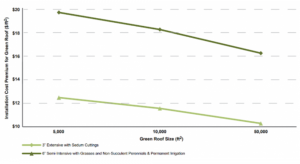
Figure 24. Green Roof Size on Installation Costs- as green roof size increases, the installation costs per square feet decreases. Adapted from The Benefits and Challenges of Green Roofs on Public and Commercial Buildings, by the United States General Service Administration, 2011.
Cost-Benefit Analysis:
Cost-benefit analysis weighs the costs of various green roof components to their benefit in a relative manner through standardization such as putting all of the costs into the net present value. A study conducted by the General Services Administration (General Service Administration, 2011) found that the overall costs and benefits of green roofs are net positive in the long-term. A table of these results is located below. The analysis compares the results nationally to the results found in Washington DC, further emphasizing the fact that the costs and benefits will change based on geography and context. The high upfront cost due to installation and the frequent maintenance during the establishment period is what deters individuals from implementing them on their own buildings. The benefit is measured in NPV, or net present value, which is a dollar amount in the net present. It is a measure of the potential profit from an investment. It measures the expected value of the future costs and benefits (with inflation considered) and turns it into the net present. A positive net present value means an investment will produce positive returns over the time frame while a negative net present value means that an investment will return losses over the time frame. This cost-benefit analysis in Figure 25 demonstrates that much of the benefits of green roofs are granted to the public, while the building owners are the ones who suffer financially.
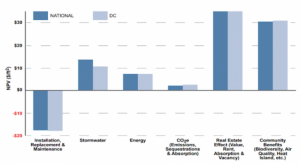
Figure 25. A Cost Benefit Analysis of Green Roofs – This graph highlights where the major costs and value is in green roofs. The installation and maintenance costs take up the majority of the negative net present value (NPV). The positive NPV mostly lies within a green roof’s benefits to the community and the pure existence of a green roof on a building’s real estate. Adapted from The Benefits and Challenges of Green Roofs on Public and Commercial Buildings, by the United States General Service Administration, 2011.
Sensitivity Analysis:
The authors of this General Service Administration study also conducted a sensitivity analysis to analyze which factors have the highest effect on benefits relative to their costs. In other words, it identifies which variables are more important based on their ability to impact the total NPV. As illustrated, roof longevity and installation costs are the most sensitive variables. A 1% change in a green roof’s lifespan increases the total net present value by 13.24% while a 1% change in initial costs increases the net present value by 11.32%. Installation costs are also the most significant cost incurred by owners, further highlighting the importance of this part of the process. Roof longevity is also an important variable in that each additional year that a green roof exists allows its benefits to exist as well. As mentioned earlier, green roofs roughly double the lifespan of a traditional roof. Sensitivity analysis is important in that it highlights the tradeoff between quality and cost, as seen in Figure 26. Building owners should keep this tradeoff in mind when considering what purpose they want their green roofs to serve.
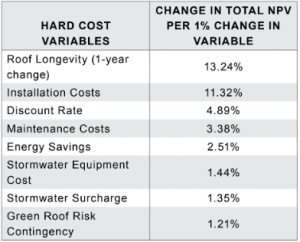
Figure 26. Sensitivity Analysis of Green Roofs highlighting which variables most impact a green roof’s value and cost. Roof longevity and installation costs are the highest variables. Adapted from The Benefits and Challenges of Green Roofs on Public and Commercial Buildings, by the United States General Service Administration, 2011.
Public vs. Private Benefits:
A major factor in determining the financial feasibility of implementing a green roof is the public and private benefits. These benefits differ greatly and therefore have a major impact concerning one’s decision to implement a green roof. In general, the largest individual benefit of green roofs are the reduction in energy use and cost for heating and cooling. Although, other individual benefits include sound insulation, roof longevity, as well as aesthetic benefits. Public benefits include reduced stormwater runoff, improved air quality, mitigation of urban heat island effect, and the promotion of urban biodiversity. Civic planners should work to encourage individuals to add green roofs so that the benefits to the community can come into existence and provide long-term sustainability of the community. Figure 27 shows the how the NPV changes based on one’s relationship to the green roof. The community has a much higher national average benefit of $29.80 per square foot of green roof compared to the owner which is near-zero Those who live in the buildings are intermediary between these two values at around $5.00 or $6.00 per square foot of green roof. The driving forces behind these differences is how owners have to pay for the installation and maintenance of their buildings while the community benefits from factors such as the mitigation of the urban heat island effect, reduced flooding risk, stormwater management, and biodiversity.

Figure 27. How NPV Differs for Community Members. This table shows much of the benefits are given to the community while owners suffer a potential financial loss. This is because the benefits change depending on one’s relation to the green roof. Adapted from The Benefits and Challenges of Green Roofs on Public and Commercial Buildings, by the United States General Service Administration, 2011.
Therefore, the question arises of who will pay for green roofs? Our research indicates that the public sector will have to implement them into society, not the private. Therefore, in conjunction with policy, taxpayers will ultimately be paying for their implementation. To help combat high overhead costs, many municipalities have enacted incentive programs. These programs subsidize the costs to individuals so that the overarching benefits of green roofs can be realized to the community. Examples of these are further explained in the policy analysis section of the report. Green roofs also help buildings achieve LEED certification. LEED certified buildings are effective in that they promote eco-friendly practices, have lower operating costs, improve public relations and health standards, as well as other benefits to the community. Some areas require newly constructed buildings to have a certain level of LEED certification, thus providing further incentive to construct a green roof.
Conclusion:
To summarize, green roofs occupy space which is considered an opportunity cost; the space and resources could be ultimately used elsewhere or for other purposes. Taxpayers fund the incentivations that the green roof policy would have. It is highly possible that the Easton citizens could choose to use these resources elsewhere, effectively choosing a do-nothing option. The differences between the benefits of green roofs for the public and private sector make their feasibility a challenge. The scale of time for the benefits to come to fruition differ between public and private. Public sectors prioritize civic planning and sustainability which could take multiple decades to occur, where the private sector focuses on individual benefits like increasing the profitability on their building, typically in a shorter time frame. In any event, a policy would be required to bring these benefits to the public; although it is up to the citizens to decide if that is how they would like to allocate their tax money.
To read the Conclusion of our report, click here.